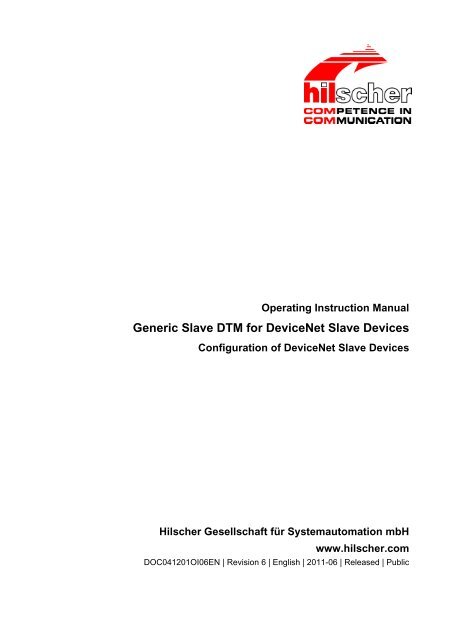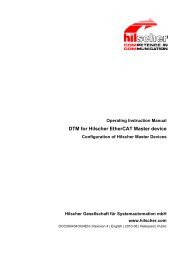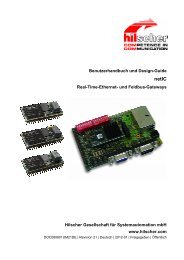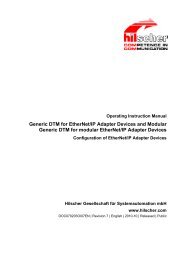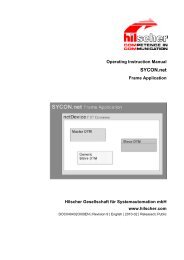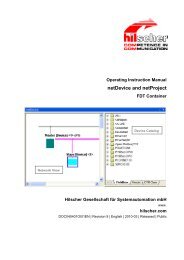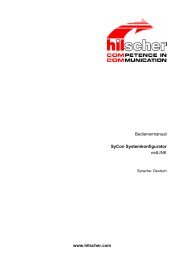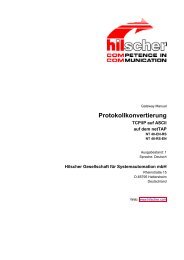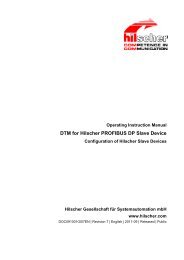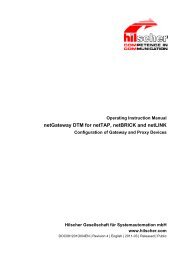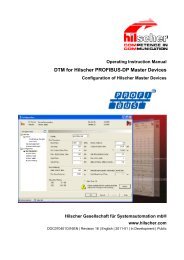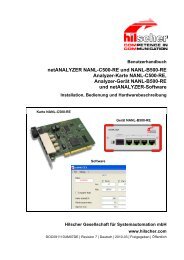SYCON.net DeviceNet Generic Slave DTM - Hilscher.fr
SYCON.net DeviceNet Generic Slave DTM - Hilscher.fr
SYCON.net DeviceNet Generic Slave DTM - Hilscher.fr
Create successful ePaper yourself
Turn your PDF publications into a flip-book with our unique Google optimized e-Paper software.
Operating Instruction Manual<br />
<strong>Generic</strong> <strong>Slave</strong> <strong>DTM</strong> for <strong>DeviceNet</strong> <strong>Slave</strong> Devices<br />
Configuration of <strong>DeviceNet</strong> <strong>Slave</strong> Devices<br />
<strong>Hilscher</strong> Gesellschaft für Systemautomation mbH<br />
www.hilscher.com<br />
DOC041201OI06EN | Revision 6 | English | 2011-06 | Released | Public
Table of Contents 2/37<br />
Table of Contents<br />
1 INTRODUCTION.........................................................................................................4<br />
1.1 About this Manual .......................................................................................................4<br />
1.1.1 Online Help...........................................................................................................4<br />
1.1.2 List of Revisions ...................................................................................................5<br />
1.1.3 Conventions in this Manual ..................................................................................6<br />
1.2 Legal Notes.................................................................................................................7<br />
1.2.1 Copyright ..............................................................................................................7<br />
1.2.2 Important Notes....................................................................................................7<br />
1.2.3 Exclusion of Liability .............................................................................................8<br />
1.2.4 Warranty ...............................................................................................................8<br />
1.2.5 Export Regulations ...............................................................................................9<br />
1.2.6 Registered Trademarks........................................................................................9<br />
1.3 About <strong>Generic</strong> <strong>DeviceNet</strong> <strong>Slave</strong> <strong>DTM</strong> ......................................................................10<br />
1.3.1 Requirements .....................................................................................................10<br />
1.4 Dialog Structure of the <strong>Generic</strong> <strong>DeviceNet</strong> <strong>Slave</strong> <strong>DTM</strong> ............................................11<br />
1.4.1 General Device Information................................................................................12<br />
1.4.2 Navigation Area..................................................................................................12<br />
1.4.3 Dialog Panes ......................................................................................................13<br />
1.4.4 OK, Cancel, Apply and Help...............................................................................14<br />
1.4.5 Table Lines .........................................................................................................14<br />
1.4.6 Status Bar...........................................................................................................15<br />
2 GETTING STARTED AND INSTRUCTIONS STEP BY STEP ..................................16<br />
2.1 Configuration Steps ..................................................................................................16<br />
2.2 Configuring Device Parameters................................................................................17<br />
3 CONFIGURATION ....................................................................................................18<br />
3.1 Overview Configuration ............................................................................................18<br />
3.2 General Settings .......................................................................................................19<br />
3.3 Connection Configuration .........................................................................................20<br />
3.3.1 Connection Types...............................................................................................20<br />
3.3.2 Watchdog Timeout Action ..................................................................................27<br />
3.4 Parameter .................................................................................................................28<br />
4 DEVICE DESCRIPTION ...........................................................................................29<br />
4.1 Overview Device Description....................................................................................29<br />
4.2 Device Info................................................................................................................30<br />
4.3 EDS Viewer ..............................................................................................................30<br />
5 LISTS ........................................................................................................................31<br />
5.1 List of Figures ...........................................................................................................31<br />
<strong>Generic</strong> <strong>Slave</strong> <strong>DTM</strong> for <strong>DeviceNet</strong> <strong>Slave</strong> Devices | Configuration of <strong>DeviceNet</strong> <strong>Slave</strong> Devices<br />
DOC041201OI06EN | Revision 6 | English | 2011-06 | Released | Public © <strong>Hilscher</strong>, 2004-2011
Table of Contents 3/37<br />
5.2 List of Tables ............................................................................................................32<br />
6 GLOSSARY...............................................................................................................33<br />
7 APPENDIX ................................................................................................................34<br />
7.1 User Rights ...............................................................................................................34<br />
7.1.1 Configuration ......................................................................................................35<br />
7.2 References ...............................................................................................................36<br />
7.3 Contacts....................................................................................................................37<br />
<strong>Generic</strong> <strong>Slave</strong> <strong>DTM</strong> for <strong>DeviceNet</strong> <strong>Slave</strong> Devices | Configuration of <strong>DeviceNet</strong> <strong>Slave</strong> Devices<br />
DOC041201OI06EN | Revision 6 | English | 2011-06 | Released | Public © <strong>Hilscher</strong>, 2004-2011
Introduction 4/37<br />
1 Introduction<br />
1.1 About this Manual<br />
This manual describes how to configure <strong>DeviceNet</strong> <strong>Slave</strong> devices, which<br />
are described with EDS files. These devices can be configured by use of<br />
the <strong>Generic</strong> <strong>DeviceNet</strong> <strong>Slave</strong> <strong>DTM</strong> within a FDT Framework.<br />
Dialog Panes<br />
The table below gives an overview for the individual dialog panes<br />
descriptions:<br />
Section Subsection Manual<br />
Page<br />
Configuration General Settings 19<br />
Connection Configuration 20<br />
Poll Connection 21<br />
Change of State Connection 23<br />
Cyclic Connection 25<br />
Bit-Strobe Connection 26<br />
Parameter 28<br />
Device Description Device Info 30<br />
EDS Viewer 30<br />
Table 1: Descriptions Dialog Panes<br />
1.1.1 Online Help<br />
The <strong>Generic</strong> <strong>DeviceNet</strong> <strong>Slave</strong> <strong>DTM</strong> contains an integrated online help<br />
facility.<br />
‣ To open the online help, click on the Help button or press the F1 key.<br />
<strong>Generic</strong> <strong>Slave</strong> <strong>DTM</strong> for <strong>DeviceNet</strong> <strong>Slave</strong> Devices | Configuration of <strong>DeviceNet</strong> <strong>Slave</strong> Devices<br />
DOC041201OI06EN | Revision 6 | English | 2011-06 | Released | Public © <strong>Hilscher</strong>, 2004-2011
Introduction 5/37<br />
1.1.2 List of Revisions<br />
Index Date Version Component Chapter Revisions<br />
1 20/12/ 1.000 - Alle created<br />
04<br />
2 03/02/ 1.001 DevNetGen<strong>Slave</strong><strong>DTM</strong>.dll Alle revised<br />
05<br />
3 13/02/<br />
06<br />
1.0.0.9 DevNetGen<strong>Slave</strong><strong>DTM</strong>.dll 1 bis 4 actualized<br />
4 09.05.<br />
07<br />
5 07.01.<br />
09<br />
6 20.06.<br />
11<br />
1.0.2.1,<br />
1.0.1.2<br />
1.0.4.0,<br />
1.0.3.0<br />
1.102.x.x<br />
,<br />
1.102.x.x<br />
DevNetGen<strong>Slave</strong><strong>DTM</strong>.dll<br />
<strong>DeviceNet</strong><strong>Generic</strong><strong>Slave</strong>Dtm<br />
Gui.ocx<br />
DevNetGen<strong>Slave</strong><strong>DTM</strong>.dll<br />
<strong>DeviceNet</strong><strong>Generic</strong><strong>Slave</strong>Dtm<br />
Gui.ocx<br />
DevNetGen<strong>Slave</strong><strong>DTM</strong>.dll<br />
<strong>DeviceNet</strong><strong>Generic</strong><strong>Slave</strong>Dtm<br />
Gui.ocx<br />
1<br />
2.1<br />
3.1<br />
4.1<br />
4.2<br />
4.3<br />
Alle<br />
1<br />
2<br />
7.2<br />
Chapter ‚Introduction’ actualized,<br />
Section ‚Overview Configuration’<br />
actualized,<br />
Section ‚Overview Device Description’<br />
actualized,<br />
Section ‚User Rights’ actualized,<br />
Section ‚Contact’ added<br />
Section ‚References’ added<br />
Manufacturer and product names<br />
generalized (completed),<br />
Chapter ’Introduction’ revised,<br />
Chapter ’Getting started’ added<br />
Section ‚User Rights’ revised,<br />
1.3.1 Section Requirements actualized<br />
<strong>Generic</strong> <strong>Slave</strong> <strong>DTM</strong> for <strong>DeviceNet</strong> <strong>Slave</strong> Devices | Configuration of <strong>DeviceNet</strong> <strong>Slave</strong> Devices<br />
DOC041201OI06EN | Revision 6 | English | 2011-06 | Released | Public © <strong>Hilscher</strong>, 2004-2011
Introduction 6/37<br />
1.1.3 Conventions in this Manual<br />
Operation instructions, a result of an operation step or notes are marked as<br />
follows:<br />
Operation Instructions:<br />
‣ <br />
Or<br />
1. <br />
2. <br />
Results:<br />
<br />
Notes:<br />
Important: <br />
Note: <br />
<br />
<strong>Generic</strong> <strong>Slave</strong> <strong>DTM</strong> for <strong>DeviceNet</strong> <strong>Slave</strong> Devices | Configuration of <strong>DeviceNet</strong> <strong>Slave</strong> Devices<br />
DOC041201OI06EN | Revision 6 | English | 2011-06 | Released | Public © <strong>Hilscher</strong>, 2004-2011
Introduction 7/37<br />
1.2 Legal Notes<br />
1.2.1 Copyright<br />
1.2.2 Important Notes<br />
© <strong>Hilscher</strong>, 2004-2011, <strong>Hilscher</strong> Gesellschaft für Systemautomation mbH<br />
All rights reserved.<br />
The images, photographs and texts in the accompanying material (user<br />
manual, accompanying texts, documentation, etc.) are protected by<br />
German and international copyright law as well as international trade and<br />
protection provisions. You are not authorized to duplicate these in whole or<br />
in part using technical or mechanical methods (printing, photocopying or<br />
other methods), to manipulate or transfer using electronic systems without<br />
prior written consent. You are not permitted to make changes to copyright<br />
notices, markings, trademarks or ownership declarations. The included<br />
diagrams do not take the patent situation into account. The company<br />
names and product descriptions included in this document may be<br />
trademarks or brands of the respective owners and may be trademarked or<br />
patented. Any form of further use requires the explicit consent of the<br />
respective rights owner.<br />
The user manual, accompanying texts and the documentation were created<br />
for the use of the products by qualified experts, however, errors cannot be<br />
ruled out. For this reason, no guarantee can be made and neither juristic<br />
responsibility for erroneous information nor any liability can be assumed.<br />
Descriptions, accompanying texts and documentation included in the user<br />
manual do not present a guarantee nor any information about proper use<br />
as stipulated in the contract or a warranted feature. It cannot be ruled out<br />
that the user manual, the accompanying texts and the documentation do<br />
not correspond exactly to the described features, standards or other data of<br />
the delivered product. No warranty or guarantee regarding the correctness<br />
or accuracy of the information is assumed.<br />
We reserve the right to change our products and their specification as well<br />
as related user manuals, accompanying texts and documentation at all<br />
times and without advance notice, without obligation to report the change.<br />
Changes will be included in future manuals and do not constitute any<br />
obligations. There is no entitlement to revisions of delivered documents.<br />
The manual delivered with the product applies.<br />
<strong>Hilscher</strong> Gesellschaft für Systemautomation mbH is not liable under any<br />
circumstances for direct, indirect, incidental or follow-on damage or loss of<br />
earnings resulting <strong>fr</strong>om the use of the information contained in this<br />
publication.<br />
<strong>Generic</strong> <strong>Slave</strong> <strong>DTM</strong> for <strong>DeviceNet</strong> <strong>Slave</strong> Devices | Configuration of <strong>DeviceNet</strong> <strong>Slave</strong> Devices<br />
DOC041201OI06EN | Revision 6 | English | 2011-06 | Released | Public © <strong>Hilscher</strong>, 2004-2011
Introduction 8/37<br />
1.2.3 Exclusion of Liability<br />
The software was produced and tested with utmost care by <strong>Hilscher</strong><br />
Gesellschaft für Systemautomation mbH and is made available as is. No<br />
warranty can be assumed for the performance and flawlessness of the<br />
software for all usage conditions and cases and for the results produced<br />
when utilized by the user. Liability for any damages that may result <strong>fr</strong>om the<br />
use of the hardware or software or related documents, is limited to cases of<br />
intent or grossly negligent violation of significant contractual obligations.<br />
Indemnity claims for the violation of significant contractual obligations are<br />
limited to damages that are foreseeable and typical for this type of contract.<br />
It is strictly prohibited to use the software in the following areas:<br />
• for military purposes or in weapon systems;<br />
• for the design, construction, maintenance or operation of nuclear<br />
facilities;<br />
• in air traffic control systems, air traffic or air traffic communication<br />
systems;<br />
• in life support systems;<br />
• in systems in which failures in the software could lead to personal injury<br />
or injuries leading to death.<br />
We inform you that the software was not developed for use in dangerous<br />
environments requiring fail-proof control mechanisms. Use of the software<br />
in such an environment occurs at your own risk. No liability is assumed for<br />
damages or losses due to unauthorized use.<br />
1.2.4 Warranty<br />
Although the hardware and software was developed with utmost care and<br />
tested intensively, <strong>Hilscher</strong> Gesellschaft für Systemautomation mbH does<br />
not guarantee its suitability for any purpose not confirmed in writing. It<br />
cannot be guaranteed that the hardware and software will meet your<br />
requirements, that the use of the software operates without interruption and<br />
that the software is <strong>fr</strong>ee of errors. No guarantee is made regarding<br />
in<strong>fr</strong>ingements, violations of patents, rights of ownership or the <strong>fr</strong>eedom <strong>fr</strong>om<br />
interference by third parties. No additional guarantees or assurances are<br />
made regarding marketability, <strong>fr</strong>eedom of defect of title, integration or<br />
usability for certain purposes unless they are required in accordance with<br />
the law and cannot be limited. Warranty claims are limited to the right to<br />
claim rectification.<br />
<strong>Generic</strong> <strong>Slave</strong> <strong>DTM</strong> for <strong>DeviceNet</strong> <strong>Slave</strong> Devices | Configuration of <strong>DeviceNet</strong> <strong>Slave</strong> Devices<br />
DOC041201OI06EN | Revision 6 | English | 2011-06 | Released | Public © <strong>Hilscher</strong>, 2004-2011
Introduction 9/37<br />
1.2.5 Export Regulations<br />
1.2.6 Registered Trademarks<br />
The delivered product (including the technical data) is subject to export or<br />
import laws as well as the associated regulations of different counters, in<br />
particular those of Germany and the USA. The software may not be<br />
exported to countries where this is prohibited by the United States Export<br />
Administration Act and its additional provisions. You are obligated to<br />
comply with the regulations at your personal responsibility. We wish to<br />
inform you that you may require permission <strong>fr</strong>om state authorities to export,<br />
re-export or import the product.<br />
Windows ® 2000/Windows ® XP/Windows ® Vista/Windows ® 7 and Windows ®<br />
CE are registered trademarks of Microsoft Corporation.<br />
<strong>DeviceNet</strong> ® is a trademark of ODVA (Open <strong>DeviceNet</strong> Vendor Association,<br />
Inc).<br />
All other mentioned trademarks are property of their respective legal<br />
owners.<br />
<strong>Generic</strong> <strong>Slave</strong> <strong>DTM</strong> for <strong>DeviceNet</strong> <strong>Slave</strong> Devices | Configuration of <strong>DeviceNet</strong> <strong>Slave</strong> Devices<br />
DOC041201OI06EN | Revision 6 | English | 2011-06 | Released | Public © <strong>Hilscher</strong>, 2004-2011
Introduction 10/37<br />
1.3 About <strong>Generic</strong> <strong>DeviceNet</strong> <strong>Slave</strong> <strong>DTM</strong><br />
You can use the <strong>Generic</strong> <strong>DeviceNet</strong> <strong>Slave</strong> <strong>DTM</strong> to configure <strong>DeviceNet</strong><br />
<strong>Slave</strong> devices described with EDS files within a FDT Framework.<br />
The information necessary for the configuration of the <strong>DeviceNet</strong> <strong>Slave</strong><br />
devices is stored within the <strong>DeviceNet</strong> Master device when using the<br />
<strong>DeviceNet</strong> <strong>Generic</strong> <strong>Slave</strong> <strong>DTM</strong> and thus the Master is configured.<br />
1.3.1 Requirements<br />
System Requirements<br />
• PC with 1 GHz processor or higher<br />
• Windows ® 2000, Windows ® XP, Windows ® Vista (32 bit), Windows ® 7<br />
(32 bit) or Windows ® 7 (64 bit)<br />
• Inter<strong>net</strong> Explorer 5.5 or higher<br />
• RAM: min. 512 MByte, recommended 1024 MByte<br />
• Graphic resolution: min. 1024 x 768 pixel<br />
• Keyboard and Mouse<br />
Note: If the project file is saved and opened again or it is used on another<br />
PC, the system requirements need to match. Particularly the <strong>DTM</strong> need to<br />
be installed on the used PC.<br />
Requirements <strong>Generic</strong> <strong>DeviceNet</strong> <strong>Slave</strong> <strong>DTM</strong><br />
Requirements for working with a <strong>Generic</strong> <strong>DeviceNet</strong> <strong>Slave</strong> <strong>DTM</strong> are:<br />
• Installed FDT/<strong>DTM</strong> V 1.2 compliant <strong>fr</strong>ame application<br />
• Installed <strong>DeviceNet</strong> Master <strong>DTM</strong><br />
• EDS files of the devices to be configured<br />
• The <strong>DTM</strong> must be loaded to the device catalog.<br />
Loading EDS files<br />
To work with the <strong>Generic</strong> <strong>DeviceNet</strong> <strong>Slave</strong> <strong>DTM</strong>, the EDS file of the used<br />
device must be copied into the EDS folder of the <strong>DTM</strong>. This folder is<br />
located in the application data directory (All Users) of the configuration<br />
software.<br />
For further information refer to section Configuration Steps on page 16 ,<br />
under step 1 and 2.<br />
<strong>Generic</strong> <strong>Slave</strong> <strong>DTM</strong> for <strong>DeviceNet</strong> <strong>Slave</strong> Devices | Configuration of <strong>DeviceNet</strong> <strong>Slave</strong> Devices<br />
DOC041201OI06EN | Revision 6 | English | 2011-06 | Released | Public © <strong>Hilscher</strong>, 2004-2011
Introduction 11/37<br />
1.4 Dialog Structure of the <strong>Generic</strong> <strong>DeviceNet</strong> <strong>Slave</strong> <strong>DTM</strong><br />
The graphical user interface of the <strong>DTM</strong> is composed of different areas and<br />
elements listed hereafter:<br />
1. A header area containing the General Device Information,<br />
2. The Navigation Area (area on the left side),<br />
3. The Dialog Pane (main area on the right side),<br />
4. The general buttons OK, Cancel, Apply, Help,<br />
5. The Status Line containing information e. g. the online-state of the<br />
<strong>DTM</strong>.<br />
General Device Information<br />
Navi<br />
gation<br />
Area<br />
Dialog Pane<br />
OK Cancel Apply Help<br />
Status Line<br />
Figure 1: Dialog Structure of the <strong>Generic</strong> <strong>DeviceNet</strong> <strong>Slave</strong> <strong>DTM</strong><br />
<strong>Generic</strong> <strong>Slave</strong> <strong>DTM</strong> for <strong>DeviceNet</strong> <strong>Slave</strong> Devices | Configuration of <strong>DeviceNet</strong> <strong>Slave</strong> Devices<br />
DOC041201OI06EN | Revision 6 | English | 2011-06 | Released | Public © <strong>Hilscher</strong>, 2004-2011
Introduction 12/37<br />
1.4.1 General Device Information<br />
Parameter<br />
Meaning<br />
IO Device<br />
Name of the device<br />
Vendor<br />
Vendor name of the device<br />
Device ID<br />
Identification number of the device<br />
Vendor ID<br />
Identification number of the vendor<br />
Table 2: General Device Information<br />
1.4.2 Navigation Area<br />
The Navigation Area contains folders and subfolders to open the dialog<br />
panes of the <strong>DTM</strong>.<br />
Figure 2: Navigation Area<br />
‣ Select the required folder and subfolder.<br />
The corresponding Dialog pane is displayed.<br />
Hide / display Navigation<br />
Hiding the navigation area (above right side).<br />
Opening the navigation area (below left side).<br />
<strong>Generic</strong> <strong>Slave</strong> <strong>DTM</strong> for <strong>DeviceNet</strong> <strong>Slave</strong> Devices | Configuration of <strong>DeviceNet</strong> <strong>Slave</strong> Devices<br />
DOC041201OI06EN | Revision 6 | English | 2011-06 | Released | Public © <strong>Hilscher</strong>, 2004-2011
Introduction 13/37<br />
1.4.3 Dialog Panes<br />
At the dialog pane the Settings or Device Description panes are opened<br />
via the corresponding folder in the navigation area.<br />
Configuration<br />
General<br />
…Connection<br />
Parameters<br />
Device Description<br />
Device<br />
EDS<br />
Table 3: Overview Dialog Panes<br />
On the page General Settings the MAC-ID can be read and the<br />
parameters ’UCMM ’, ’Fragmentation Timeout’ or ’Verify Device<br />
ID’ can be preset. Further information to this you find in section<br />
General Settings on page 19.<br />
On the page Connection Configuration a connection type can be<br />
selected and configured. Further information to this you find in<br />
section Connection Configuration on page 20.<br />
In the Parameter dialog the parameter data of the device can be<br />
edited. A detailed description you find in section Parameter on<br />
page 28.<br />
The Device Info pane contains the manufacturer information<br />
about the device. For further information see section Device Info<br />
on page 30.<br />
By use of the EDS-Viewer an EDS file can be viewed and<br />
searched through. For further information see section EDS<br />
Viewer on page 30.<br />
<strong>Generic</strong> <strong>Slave</strong> <strong>DTM</strong> for <strong>DeviceNet</strong> <strong>Slave</strong> Devices | Configuration of <strong>DeviceNet</strong> <strong>Slave</strong> Devices<br />
DOC041201OI06EN | Revision 6 | English | 2011-06 | Released | Public © <strong>Hilscher</strong>, 2004-2011
Introduction 14/37<br />
1.4.4 OK, Cancel, Apply and Help<br />
OK, Cancel, Apply and Help you can use as described hereafter.<br />
OK<br />
Cancel<br />
Apply<br />
Help<br />
Meaning<br />
To confirm your latest settings, click OK. All changed values will be applied<br />
on the <strong>fr</strong>ame application database.<br />
The dialog then closes.<br />
To cancel your latest changes, click Cancel.<br />
Answer to the safety query Configuration data has been changed. Do<br />
you want to save the data? by Yes, No or Cancel.<br />
Yes: The changes are saved or the changed values are applied on the<br />
<strong>fr</strong>ame application database.<br />
The dialog then closes.<br />
No: The changes are not saved or the changed values are not applied on<br />
the <strong>fr</strong>ame application database.<br />
The dialog then closes.<br />
Cancel: Back to the <strong>DTM</strong>.<br />
To confirm your latest settings, click Apply. All changed values will be<br />
applied on the <strong>fr</strong>ame application database.<br />
The dialog remains opened.<br />
To open the <strong>DTM</strong> online help, click Help.<br />
Table 4: OK, Cancel, Apply and Help<br />
1.4.5 Table Lines<br />
In the <strong>DTM</strong> dialog pane table lines can be selected, inserted or deleted.<br />
Meaning<br />
To select the first line of a table use First Line.<br />
To select the previous line of a table use Previous Line.<br />
To select the next line of a table use Next Line.<br />
To select the last line of a table use Last Line.<br />
Create a new Line inserts new lines into the table.<br />
Delete selected Line deletes the selected line <strong>fr</strong>om the table.<br />
Table 5: Selecting, inserting, deleting Table Line<br />
<strong>Generic</strong> <strong>Slave</strong> <strong>DTM</strong> for <strong>DeviceNet</strong> <strong>Slave</strong> Devices | Configuration of <strong>DeviceNet</strong> <strong>Slave</strong> Devices<br />
DOC041201OI06EN | Revision 6 | English | 2011-06 | Released | Public © <strong>Hilscher</strong>, 2004-2011
Introduction 15/37<br />
1.4.6 Status Bar<br />
The Status Bar displays information about the current state of the <strong>DTM</strong>.<br />
The current activity, e.g. the <strong>DTM</strong> connection state, is signaled graphically<br />
via icons in the status bar.<br />
Figure 3: Status Bar – Status Fields 1 to 6<br />
Status Icon / Meaning<br />
Field<br />
1 <strong>DTM</strong> Connection States<br />
Connected: Icon closed = Device is online<br />
Disconnected: Icon opened = Device is offline<br />
2 Data Source States<br />
Data set: The displayed data are read out <strong>fr</strong>om the instance data set<br />
(database).<br />
Device: The displayed data are read out <strong>fr</strong>om the device.<br />
3 States of the instance Date Set<br />
Valid Modified: Parameter is changed (not equal to data source).<br />
Table 6: Status Bar Icons [1]<br />
Offline State<br />
Figure 4: Status Bar Display Example<br />
<strong>Generic</strong> <strong>Slave</strong> <strong>DTM</strong> for <strong>DeviceNet</strong> <strong>Slave</strong> Devices | Configuration of <strong>DeviceNet</strong> <strong>Slave</strong> Devices<br />
DOC041201OI06EN | Revision 6 | English | 2011-06 | Released | Public © <strong>Hilscher</strong>, 2004-2011
Getting started and Instructions Step by Step 16/37<br />
2 Getting started and Instructions Step by Step<br />
2.1 Configuration Steps<br />
The following table describes the steps to configure a device with the<br />
<strong>Generic</strong> <strong>DeviceNet</strong> <strong>Slave</strong> <strong>DTM</strong> as it is typical for many cases. At this time it<br />
is presupposed that the <strong>DeviceNet</strong> Master <strong>DTM</strong> installation was already<br />
done.<br />
# Step Short Description For detailed information<br />
see section<br />
1 Add <strong>DeviceNet</strong><br />
<strong>Slave</strong> in the<br />
Device Catalog<br />
2 Load device<br />
catalog<br />
3 Create new<br />
project / Open<br />
existing project<br />
4 Insert Controller<br />
or Device into<br />
configuration<br />
Add the Device in the Device Catalog by<br />
importing the device description file to the Device<br />
Catalog.<br />
Depending of the FDT Container.<br />
For <strong>net</strong>Device:<br />
- Network > Import Device Descriptions.<br />
Depending of the FDT Container:<br />
For <strong>net</strong>Device:<br />
- select Network > Device Catalog,<br />
- select button Reload Catalog.<br />
Depending of the <strong>fr</strong>ame application.<br />
For the configuration software:<br />
- select File > New or File > Open.<br />
Depending of the FDT Container:<br />
For <strong>net</strong>Device:<br />
- in the Device Catalog click to the Controller,<br />
- and insert the device via drag and drop<br />
to the line in the <strong>net</strong>work view,<br />
- in the Device Catalog click to the Device,<br />
- and insert the device via drag and drop<br />
to the Controller bus line in the <strong>net</strong>work view.<br />
5 Configure Device Configure the Device.<br />
- Double click to the device icon of the Device.<br />
- The <strong>Generic</strong> Device <strong>DTM</strong> configuration dialog is<br />
displayed.<br />
In the <strong>Generic</strong> Device <strong>DTM</strong> configuration dialog:<br />
- select Configuration >General,<br />
- set UCMM and Fragmentation Timeout,<br />
- select Configuration > Connection,<br />
- configure the device connection,<br />
- select Configuration >Parameter,<br />
- set the parameter data of the device,<br />
- close the <strong>Generic</strong> Device <strong>DTM</strong> configuration<br />
dialog via the button OK.<br />
6 Configuration<br />
Steps Controller<br />
device<br />
Configure the Controller device via <strong>DeviceNet</strong><br />
Master <strong>DTM</strong>.<br />
7 Save project Depending of the <strong>fr</strong>ame application.<br />
For the configuration software:<br />
- select File > Save.<br />
Table 7: Getting started - Configuration Steps<br />
(See User Manual <strong>net</strong>Device<br />
and <strong>net</strong>Project)<br />
(See User Manual <strong>net</strong>Device<br />
and <strong>net</strong>Project)<br />
(See User Manual of the<br />
Frame Application)<br />
(See User Manual of the<br />
Frame Application)<br />
Configuring Device<br />
Parameters<br />
General Settings<br />
Connection Configuration<br />
Parameter<br />
(See User Manual <strong>DTM</strong> for<br />
<strong>DeviceNet</strong> Master devices)<br />
(See User Manual of the<br />
Frame Application)<br />
Page<br />
-<br />
-<br />
-<br />
-<br />
17<br />
19<br />
20<br />
28<br />
-<br />
-<br />
For information to further steps as Download Configuration or<br />
Diagnosis, refer to the user manual <strong>DTM</strong> for <strong>DeviceNet</strong> Master devices.<br />
<strong>Generic</strong> <strong>Slave</strong> <strong>DTM</strong> for <strong>DeviceNet</strong> <strong>Slave</strong> Devices | Configuration of <strong>DeviceNet</strong> <strong>Slave</strong> Devices<br />
DOC041201OI06EN | Revision 6 | English | 2011-06 | Released | Public © <strong>Hilscher</strong>, 2004-2011
Getting started and Instructions Step by Step 17/37<br />
2.2 Configuring Device Parameters<br />
The following steps are needed to configure the device parameters using<br />
the <strong>Generic</strong> <strong>DeviceNet</strong> <strong>Slave</strong> <strong>DTM</strong>:<br />
1. Set UCMM and Fragmentation Timeout.<br />
‣ Select Configuration > General in the navigation area.<br />
2. Configure the device connection.<br />
‣ Select Configuration > Connection in the navigation area.<br />
3. Set the parameter data of the device.<br />
‣ Select Configuration > Parameter in the navigation area.<br />
For more information refer to section General Settings on page 19,<br />
Connection Configuration on page 20 and Parameter on page 28.<br />
<strong>Generic</strong> <strong>Slave</strong> <strong>DTM</strong> for <strong>DeviceNet</strong> <strong>Slave</strong> Devices | Configuration of <strong>DeviceNet</strong> <strong>Slave</strong> Devices<br />
DOC041201OI06EN | Revision 6 | English | 2011-06 | Released | Public © <strong>Hilscher</strong>, 2004-2011
Configuration 18/37<br />
3 Configuration<br />
3.1 Overview Configuration<br />
Configuration Dialog Panes<br />
Note: Access to the configuration panes is enabled without requirement<br />
of user rights. However for editing certain user rights are required. Further<br />
information can be found in section and User Rights on page 34.<br />
The table below gives an overview for the Configuration dialog panes<br />
descriptions:<br />
Section Subsection Page<br />
Configuration General Settings 19<br />
Connection Configuration 20<br />
Poll Connection 21<br />
Change of State Connection 23<br />
Cyclic Connection 25<br />
Bit-Strobe Connection 26<br />
Parameter 28<br />
Table 8: Descriptions of the Configuration Dialog Panes<br />
Figure 5: Navigation Area - Configuration
Configuration 19/37<br />
3.2 General Settings<br />
The Dialog General Settings contains the following configuration<br />
possibilities:<br />
Figure 6: General Settings - Attributes of the device identification<br />
Parameter Meaning Range of Value<br />
MAC ID The MAC ID is assigned by the Master and can not be edited 0 … 63<br />
here. Changing the MAC ID has to be made with the <strong>DeviceNet</strong><br />
Master <strong>DTM</strong>.<br />
With each device inserted into the configuration the MAC ID is<br />
increased automatically by one.<br />
UCMM If the field UCMM is selected, the device is used as UCMMcompatible<br />
device.<br />
Fragmentatio<br />
n Timeout<br />
The option UCMM is used for devices which need the UCMM<br />
message format. Group 1, 2 and 3 are supported. The<br />
documentation of the used device gives information whether this<br />
option is to be used or not.<br />
Fragmentation Timeout (Expl. Message Timeout): If an IO data<br />
transmission or an Explicit Message is larger than 8 byte, this<br />
must be transferred <strong>fr</strong>agmented in the <strong>DeviceNet</strong> (in several<br />
telegrams).<br />
The Fragmentation Timeout specifies, how long the Master<br />
waits, until a <strong>Slave</strong> answers a <strong>fr</strong>agmented telegram.<br />
Note: Small values can lead to communication disturbances.<br />
Table 9: General Settings - Attributes of the device identification<br />
Group1,<br />
Group2,<br />
Group3<br />
0 … 1700 … 65535<br />
Figure 7: General Settings - Verify Device ID<br />
The function Verify Device ID compares the device description in the EDS<br />
file of the device with the existing hardware, if the device characteristics of<br />
the EDS file agree with those of the hardware.<br />
The check is made for the selected attributes in each case.<br />
<strong>Generic</strong> <strong>Slave</strong> <strong>DTM</strong> for <strong>DeviceNet</strong> <strong>Slave</strong> Devices | Configuration of <strong>DeviceNet</strong> <strong>Slave</strong> Devices<br />
DOC041201OI06EN | Revision 6 | English | 2011-06 | Released | Public © <strong>Hilscher</strong>, 2004-2011
Configuration 20/37<br />
3.3 Connection Configuration<br />
<strong>DeviceNet</strong> allows establishing several kinds of Connections between<br />
devices. In <strong>DeviceNet</strong> a device (<strong>Slave</strong>) is mapped as a collection of objects.<br />
These objects communicate via different connection types, which you can<br />
adjust under Connection.<br />
Figure 8: Configuration Dialog Connection<br />
In the Connection dialog a connection type or a combination of types can<br />
be selected. Please note that a device has not to support all types of IO<br />
connections. Connection types which are not supported by the device are<br />
automatically disabled.<br />
In the lower section of this dialog the possible combinations of the<br />
connection types are displayed:<br />
Figure 9: Indication of possible combinations of connection types<br />
If an invalid combination is set, the following warning appears:<br />
Figure 10: Warning invalid connection type combination<br />
3.3.1 Connection Types<br />
The following connection types are available:<br />
Connection Type<br />
Page<br />
Poll Connection 21<br />
Change of State Connection 23<br />
Cyclic Connection 25<br />
Bit-Strobe Connection 26<br />
Table 10: Possible connection types<br />
<strong>Generic</strong> <strong>Slave</strong> <strong>DTM</strong> for <strong>DeviceNet</strong> <strong>Slave</strong> Devices | Configuration of <strong>DeviceNet</strong> <strong>Slave</strong> Devices<br />
DOC041201OI06EN | Revision 6 | English | 2011-06 | Released | Public © <strong>Hilscher</strong>, 2004-2011
Configuration 21/37<br />
3.3.1.1 Poll Connection<br />
If the Poll Connection type was activated, the elements of this connection<br />
type are editable. Otherwise this dialog is disabled.<br />
Figure 11: Poll Connection - Consumption and Production<br />
One poll command <strong>fr</strong>om the Master sends a number of output data in the<br />
poll command to the device. The device receives (consumes) the output<br />
data. If it has input data configured for this poll connection it reacts by<br />
sending (producing) back the number of input data to the Master. Before a<br />
polled I/O connection is initiated by the Master, it reads the consumed and<br />
produced connection size of the data <strong>fr</strong>om the device (<strong>Slave</strong>) first and<br />
compares this values with the values configured in Master. If different<br />
values are detected, the connection cannot be established. A poll<br />
command can be sent <strong>fr</strong>om the Master to a device. The device has to<br />
respond if it has received the poll command of the Master, even if it has no<br />
input data. Else the Master will report a timeout error. Polling data to many<br />
devices has the disadvantage that the <strong>net</strong>work traffic rate is very high and<br />
most data which is transferred has not changed since the last transmission.<br />
Furthermore the higher the bus load more communication errors can occur<br />
if the bus is disturbed by external influences.<br />
Figure 12: Poll Connection – Timing
Configuration 22/37<br />
The Production Inhibit Time, one for each connection, configures the<br />
minimum delay time between new data production in multiples of a<br />
millisecond. The timer is reloaded each time new data production through<br />
the established connection occurs. While the timer is running the device<br />
suppresses new data production until the timer has expired. This method<br />
prevents that the device is overloaded with to fast incoming requests.<br />
The value 0 defines no Production Inhibit Time and data production can<br />
and will be done as fast as possible. If in polled mode for example a<br />
Production Inhibit Time of 1000 ms is configured, then the poll request<br />
message to the device will be sent every second.<br />
The Expected Packet Rate, one for each connection, is always transferred<br />
to the device before starting and doing the I/O transfer. The fourfold value<br />
is used by the device later to reload its 'Watchdog Timer'. If no data<br />
production of the remote station takes place within this time, so the<br />
connection changes into a watchdog timeout error. Incoming data<br />
productions of the remote station load the Watchdog Time again to the<br />
fourfold value of the Expected Packet Rate.<br />
Note: the Production Inhibit Time is verified against the Expected<br />
Packet Rate. If the Expected Packet Rate value is unequal to zero, but<br />
less than the Production Inhibit Time value, then an error message is<br />
displayed by the application.<br />
A description about the pull-down menu Watchdog Timeout Action you<br />
find in section Watchdog Timeout Action on page 27.<br />
<strong>Generic</strong> <strong>Slave</strong> <strong>DTM</strong> for <strong>DeviceNet</strong> <strong>Slave</strong> Devices | Configuration of <strong>DeviceNet</strong> <strong>Slave</strong> Devices<br />
DOC041201OI06EN | Revision 6 | English | 2011-06 | Released | Public © <strong>Hilscher</strong>, 2004-2011
Configuration 23/37<br />
3.3.1.2 Change of State Connection<br />
If the Change of State Connection type was activated, the elements of<br />
this connection type are editable. Otherwise this dialog is disabled.<br />
Figure 13: Change of State Connection - Consumption and Production<br />
With this type of connection both Master and <strong>Slave</strong> send the configured<br />
amount of data (max. 255 Byte) to the respective remote station. This data<br />
production is started at change in value (trigger). If the data production<br />
does not take place during a defined time interval, the devices trigger the<br />
data production automatically to load the Watchdog Timer of the connection<br />
again. Depending on how the device behavior is configured, they can send<br />
back a confirmation message which contains any quantity of data and/or<br />
status information. Before a Change of State connection is initialized by<br />
the Master, it reads out the consumed and produced connection size of the<br />
data <strong>fr</strong>om the device (<strong>Slave</strong>) and compares this values with the values<br />
configured in the Master during configuration. If different values are<br />
determined, the connection can not build up. Data production only over<br />
'Change of State' keeps the bus load as low as possible, while data than<br />
can be transmitted as fast as possible by each device because bus<br />
conflicts are less possible. So you can get high performance data<br />
transmission with in comparison low baud rates.<br />
Figure 14: Change of State Connection – Timing<br />
<strong>Generic</strong> <strong>Slave</strong> <strong>DTM</strong> for <strong>DeviceNet</strong> <strong>Slave</strong> Devices | Configuration of <strong>DeviceNet</strong> <strong>Slave</strong> Devices<br />
DOC041201OI06EN | Revision 6 | English | 2011-06 | Released | Public © <strong>Hilscher</strong>, 2004-2011
Configuration 24/37<br />
The Production Inhibit Time, one for each connection, configures the<br />
minimum delay time between new data production in multiples of a<br />
millisecond. The timer is reloaded each time new data production through<br />
the established connection occurs. While the timer is running the device<br />
suppresses new data production until the timer has expired. This method<br />
prevents that the device is overloaded with to fast incoming requests.<br />
The value 0 defines no Production Inhibit Time and data production can<br />
and will be done as fast as possible.<br />
The Expected Packet Rate, one for each connection, is always transferred<br />
to the device before starting and doing the I/O transfer. The value is used<br />
by the device to reload its 'Transmission Trigger' and 'Watchdog Timer'. In<br />
Change of State connections the fourfold value of the Expected Packet<br />
Rate is used to build the 'Watchdog Timer'. If no data production of the<br />
remote station takes place within this time, so the connection changes into<br />
a watchdog timeout error. Incoming data productions of the remote station<br />
load the Watchdog Time again to the fourfold value of the Expected<br />
Packet Rate.<br />
If a data production did not take place since starting the 'Transmission<br />
Trigger Timer' as single values of the Expected Packet Rate, so the device<br />
triggers a data production at the latest then automatically.<br />
Note: the Production Inhibit Time is verified against the Expected<br />
Packet Rate. If the Expected Packet Rate value is unequal to zero, but<br />
less than the Production Inhibit Time value, then an error message is<br />
displayed by the application.<br />
A description about the pull-down menu Watchdog Timeout Action you<br />
find in section Watchdog Timeout Action on page 27.<br />
<strong>Generic</strong> <strong>Slave</strong> <strong>DTM</strong> for <strong>DeviceNet</strong> <strong>Slave</strong> Devices | Configuration of <strong>DeviceNet</strong> <strong>Slave</strong> Devices<br />
DOC041201OI06EN | Revision 6 | English | 2011-06 | Released | Public © <strong>Hilscher</strong>, 2004-2011
Configuration 25/37<br />
3.3.1.3 Cyclic Connection<br />
If the Cyclic Connection type was activated, the elements of this<br />
connection type are editable. Otherwise this dialog is disabled.<br />
Figure 15: Cyclic Connection - Consumption and Production<br />
At this transmission type a data production takes place automatically, if the<br />
'Transmission Trigger Timer' has expired as single value of the Expected<br />
Packet Rate.<br />
Figure 16: Cyclic Connection - Timing<br />
The Expected Packet Rate, one for each connection, is always transferred<br />
to the device before starting and doing the I/O transfer. The value is used<br />
by the device to reload its 'Transmission Trigger' and 'Watchdog Timer'. In<br />
Cyclic connections the fourfold value of the Expected Packet Rate is used<br />
to reload the 'Transmission Trigger Timer' and the 'Watchdog Timer'. If no<br />
data production of the remote station takes place within this time, so the<br />
connection changes into a watchdog timeout error. Incoming data<br />
productions of the remote station load the Watchdog Time again to the<br />
fourfold value of the Expected Packet Rate.<br />
A description about the pull-down menu Watchdog Timeout Action you<br />
find in section Watchdog Timeout Action on page 27.<br />
<strong>Generic</strong> <strong>Slave</strong> <strong>DTM</strong> for <strong>DeviceNet</strong> <strong>Slave</strong> Devices | Configuration of <strong>DeviceNet</strong> <strong>Slave</strong> Devices<br />
DOC041201OI06EN | Revision 6 | English | 2011-06 | Released | Public © <strong>Hilscher</strong>, 2004-2011
Configuration 26/37<br />
3.3.1.4 Bit-Strobe Connection<br />
If the Bit-Strobe Connection type was activated, the elements of this<br />
connection type are editable. Otherwise this dialog is disabled.<br />
Figure 17: Bit-Strobe Connection - Consumption and Production<br />
Bit strobe command and response messages rapidly move small amounts<br />
of output data between the Master device and one/some/all <strong>Slave</strong> devices.<br />
The bit strobe message contains a bit string of 64 bits of output data, one<br />
output bit per possible device. Each bit in there is assigned to one device<br />
address (MAC-ID) in the <strong>net</strong>work. Herewith this service has broadcast<br />
functionality that means more than one <strong>Slave</strong> device can be addressed by<br />
one command. Because all addressed <strong>Slave</strong> devices get this command at<br />
the same time, this command is normally used to synchronize data transfer<br />
to several <strong>Slave</strong> devices. A <strong>Slave</strong> device can take its corresponding output<br />
bit as a real output information to give it to the peripheral connections (e.g.<br />
an LED) and/or use the bit as a trigger to send back its input data with a<br />
poll response message. The data that can be sent back <strong>fr</strong>om each <strong>Slave</strong><br />
after a bit strobe command was received is limited to 8 bytes in length. Bit<br />
strobe usage causes therefore a reduced bus loading than poll<br />
connections.<br />
Figure 18: Bit-Strobe Connection - Timing<br />
The Expected Packet Rate, one for each connection, is always transferred<br />
to the device before starting and doing the I/O transfer. The fourfold value<br />
is used by the device later to reload its 'Watchdog Timer'. If no data<br />
production of the remote station takes place within this time, so the<br />
connection changes into a watchdog timeout error. Incoming data<br />
productions of the remote station load the Watchdog Time again to the<br />
fourfold value of the Expected Packet Rate.<br />
A description about the pull-down menu Watchdog Timeout Action you<br />
find in section Watchdog Timeout Action on page 27.<br />
<strong>Generic</strong> <strong>Slave</strong> <strong>DTM</strong> for <strong>DeviceNet</strong> <strong>Slave</strong> Devices | Configuration of <strong>DeviceNet</strong> <strong>Slave</strong> Devices<br />
DOC041201OI06EN | Revision 6 | English | 2011-06 | Released | Public © <strong>Hilscher</strong>, 2004-2011
Configuration 27/37<br />
3.3.2 Watchdog Timeout Action<br />
The Watchdog Timeout Action defines the device behavior when the<br />
watchdog timer in the device (<strong>Slave</strong>) expires. The following actions are<br />
adjustable:<br />
• Timeout: The connection transitions to the timeout state and remains in<br />
this state until it is Reset or Deleted.<br />
• Auto delete: The connection class automatically deletes the connection<br />
if it experiences an Inactivity/Watchdog timeout.<br />
• Auto reset: The connection remains in the established state and<br />
immediately restarts the Inactivity/Watchdog timer.<br />
<strong>Generic</strong> <strong>Slave</strong> <strong>DTM</strong> for <strong>DeviceNet</strong> <strong>Slave</strong> Devices | Configuration of <strong>DeviceNet</strong> <strong>Slave</strong> Devices<br />
DOC041201OI06EN | Revision 6 | English | 2011-06 | Released | Public © <strong>Hilscher</strong>, 2004-2011
Configuration 28/37<br />
3.4 Parameter<br />
In the Parameter dialog the parameter data of the device can be edited.<br />
If default parameters are configured in the EDS file for this device, these<br />
are inserted automatically. Some of devices need further parameterization<br />
data, to change for example a measurement limitation or a value range.<br />
These data are device specific and their functionality can not be explained<br />
at this point. The explanation can be found in the corresponding device<br />
manual.<br />
Figure 19: Parameter Configuration<br />
Parameter Value Description<br />
Parameter Group ALL<br />
USER<br />
DEFINED<br />
xxx<br />
All parameter groups defined in the EDS file are merged in one<br />
table.<br />
A parameter group defined by the user is displayed.<br />
In the EDS file of the device further parameter groups can be<br />
defined, which are also displayed in the pull-down menu<br />
Parameter Group. The name of this parameter group itself is also<br />
defined in the EDS file.<br />
Display Mode Decimal The values Min and Max in the table are indicated in decimal<br />
Hexadecimal<br />
notation by default. By selecting the Display Mode Hexadecimal<br />
the values are shown in hexadecimal notation.<br />
Table 11: Change Parameter Data<br />
By using a data set the respective parameter value for the Master<br />
configuration are approved and transferred to the <strong>Slave</strong> by the Master<br />
during the initialization phase.<br />
A description of the individual parameters, indicated by Class, Instance<br />
and Attribute, can be refered in the device description of the manufacturer.<br />
If “User Defined” is selected in Parameter Group, the entries in the<br />
columns Param. Name and Value are editable. Otherwise the entries are<br />
fixed and can not be changed.<br />
<strong>Generic</strong> <strong>Slave</strong> <strong>DTM</strong> for <strong>DeviceNet</strong> <strong>Slave</strong> Devices | Configuration of <strong>DeviceNet</strong> <strong>Slave</strong> Devices<br />
DOC041201OI06EN | Revision 6 | English | 2011-06 | Released | Public © <strong>Hilscher</strong>, 2004-2011
Device Description 29/37<br />
4 Device Description<br />
4.1 Overview Device Description<br />
Descriptions of “Device Description”<br />
The table below gives an overview for the Device Description dialog<br />
panes descriptions:<br />
Section Subsection Page<br />
Device Description Device Info 30<br />
EDS Viewer 30<br />
Table 12: Descriptions of the Dialog Panes Device Description<br />
Device Description Dialog Panes<br />
Figure 20: Navigation Area - Device Description<br />
<strong>Generic</strong> <strong>Slave</strong> <strong>DTM</strong> for <strong>DeviceNet</strong> <strong>Slave</strong> Devices | Configuration of <strong>DeviceNet</strong> <strong>Slave</strong> Devices<br />
DOC041201OI06EN | Revision 6 | English | 2011-06 | Released | Public © <strong>Hilscher</strong>, 2004-2011
Device Description 30/37<br />
4.2 Device Info<br />
The Device Info dialog contains manufacturer information about the<br />
device, which is defined in the EDS file. The following information is<br />
indicated:<br />
Parameter<br />
Vendor name<br />
Vendor ID<br />
Product Type<br />
Product Type String<br />
Product Code<br />
Product Name<br />
Major Revision<br />
Minor Revision<br />
Catalog<br />
Icon filei<br />
Table 13: General Device Information<br />
Meaning<br />
Vendor name of the device<br />
Identification number of the manufacturer<br />
Communication Adapter<br />
Product Name as string<br />
Product code of the device<br />
Name of the device<br />
The variable Product Name is a text string that should represent<br />
a short description of the product/product family.<br />
Major Revision<br />
Minor Revision<br />
Used catalog name<br />
Udes icon file name<br />
4.3 EDS Viewer<br />
The EDS Viewer shows the content of the EDS file in a text view.<br />
Under Filename the file directory path and the file name of the displayed<br />
EDS file is displayed. Find what offers a search feature to search for text<br />
contents within the text of the EDS file.<br />
In the EDS Viewer window on the left side, the line number is displayed for<br />
simple overview, the further entries show the EDS file in text format.<br />
Parameter<br />
Filename<br />
Find what<br />
Match case<br />
Match whole word<br />
Table 14: Device Description – EDS Viewer<br />
Meaning<br />
File directory path and the file name of the displayed EDS file.<br />
Search feature to search for text contents within the text of the<br />
EDS file.<br />
Search option<br />
Search option<br />
<strong>Generic</strong> <strong>Slave</strong> <strong>DTM</strong> for <strong>DeviceNet</strong> <strong>Slave</strong> Devices | Configuration of <strong>DeviceNet</strong> <strong>Slave</strong> Devices<br />
DOC041201OI06EN | Revision 6 | English | 2011-06 | Released | Public © <strong>Hilscher</strong>, 2004-2011
Lists 31/37<br />
5 Lists<br />
5.1 List of Figures<br />
Figure 1: Dialog Structure of the <strong>Generic</strong> <strong>DeviceNet</strong> <strong>Slave</strong> <strong>DTM</strong> 11<br />
Figure 2: Navigation Area 12<br />
Figure 3: Status Bar – Status Fields 1 to 6 15<br />
Figure 4: Status Bar Display Example 15<br />
Figure 5: Navigation Area - Configuration 18<br />
Figure 6: General Settings - Attributes of the device identification 19<br />
Figure 7: General Settings - Verify Device ID 19<br />
Figure 8: Configuration Dialog Connection 20<br />
Figure 9: Indication of possible combinations of connection types 20<br />
Figure 10: Warning invalid connection type combination 20<br />
Figure 11: Poll Connection - Consumption and Production 21<br />
Figure 12: Poll Connection – Timing 21<br />
Figure 13: Change of State Connection - Consumption and Production 23<br />
Figure 14: Change of State Connection – Timing 23<br />
Figure 15: Cyclic Connection - Consumption and Production 25<br />
Figure 16: Cyclic Connection - Timing 25<br />
Figure 17: Bit-Strobe Connection - Consumption and Production 26<br />
Figure 18: Bit-Strobe Connection - Timing 26<br />
Figure 19: Parameter Configuration 28<br />
Figure 20: Navigation Area - Device Description 29<br />
<strong>Generic</strong> <strong>Slave</strong> <strong>DTM</strong> for <strong>DeviceNet</strong> <strong>Slave</strong> Devices | Configuration of <strong>DeviceNet</strong> <strong>Slave</strong> Devices<br />
DOC041201OI06EN | Revision 6 | English | 2011-06 | Released | Public © <strong>Hilscher</strong>, 2004-2011
Lists 32/37<br />
5.2 List of Tables<br />
Table 1: Descriptions Dialog Panes 4<br />
Table 2: General Device Information 12<br />
Table 3: Overview Dialog Panes 13<br />
Table 4: OK, Cancel, Apply and Help 14<br />
Table 5: Selecting, inserting, deleting Table Line 14<br />
Table 6: Status Bar Icons [1] 15<br />
Table 7: Getting started - Configuration Steps 16<br />
Table 8: Descriptions of the Configuration Dialog Panes 18<br />
Table 9: General Settings - Attributes of the device identification 19<br />
Table 10: Possible connection types 20<br />
Table 11: Change Parameter Data 28<br />
Table 12: Descriptions of the Dialog Panes Device Description 29<br />
Table 13: General Device Information 30<br />
Table 14: Device Description – EDS Viewer 30<br />
Table 15: User Rights - General Settings (D = Displaying, X = Editing, Configuring) 35<br />
Table 16: User Rights – Connection (D = Displaying, X = Editing, Configuring) 35<br />
Table 17: User Rights – Parameter (D = Displaying, X = Editing, Configuring) 36<br />
<strong>Generic</strong> <strong>Slave</strong> <strong>DTM</strong> for <strong>DeviceNet</strong> <strong>Slave</strong> Devices | Configuration of <strong>DeviceNet</strong> <strong>Slave</strong> Devices<br />
DOC041201OI06EN | Revision 6 | English | 2011-06 | Released | Public © <strong>Hilscher</strong>, 2004-2011
Glossary 33/37<br />
6 Glossary<br />
<strong>DTM</strong><br />
EDS<br />
FDT<br />
MAC ID<br />
Device Type Manager<br />
The Device Type Manager (<strong>DTM</strong>) is a software module with grafical user<br />
interface for the configuration and/or for diagnosis of devices.<br />
An Electronic Data Sheet (EDS) provides information necessary to access<br />
and alter the configurable parameters of a device. An Electronic Data Sheet<br />
(EDS) is an external file that contains information about configurable<br />
attributes for the device, including object addresses of each parameter. The<br />
application objects in a device represent the destination addresses for<br />
configuration data. These addresses are encoded in the EDS.<br />
Field Device Tool<br />
FDT specifies an interface, in order to be able to use <strong>DTM</strong> (Device Type<br />
Manager) in different applications of different manufacturers.<br />
The <strong>net</strong>work address of a device serves to distinguish itself on a <strong>DeviceNet</strong><br />
fieldbus system <strong>fr</strong>om any other device or <strong>Slave</strong> on this <strong>net</strong>work. This should<br />
be a unique number for each device.<br />
<strong>Generic</strong> <strong>Slave</strong> <strong>DTM</strong> for <strong>DeviceNet</strong> <strong>Slave</strong> Devices | Configuration of <strong>DeviceNet</strong> <strong>Slave</strong> Devices<br />
DOC041201OI06EN | Revision 6 | English | 2011-06 | Released | Public © <strong>Hilscher</strong>, 2004-2011
Appendix 34/37<br />
7 Appendix<br />
7.1 User Rights<br />
User-rights are set within the FDT-container. Depending on the level the<br />
configuration is accessible by the user or read-only.<br />
To access the Configuration and Device Description panes of the<br />
<strong>Generic</strong> <strong>DeviceNet</strong> <strong>Slave</strong> <strong>DTM</strong> you do not need special user rights.<br />
Note: To edit, set or configure the parameters of the Configuration<br />
panes, you need user rights for Maintenance, for Planning Engineer or for<br />
Administrator.<br />
The Device Description panes do not contain any editable elements. The<br />
indicated values in are only for information purposes.<br />
The following tables give an overview of the user right groups and which<br />
user rights you need to configure the single parameters.<br />
<strong>Generic</strong> <strong>Slave</strong> <strong>DTM</strong> for <strong>DeviceNet</strong> <strong>Slave</strong> Devices | Configuration of <strong>DeviceNet</strong> <strong>Slave</strong> Devices<br />
DOC041201OI06EN | Revision 6 | English | 2011-06 | Released | Public © <strong>Hilscher</strong>, 2004-2011
Appendix 35/37<br />
7.1.1 Configuration<br />
General Settings<br />
Observer<br />
Operator<br />
Maintenance<br />
Planning<br />
Engineer<br />
Administrator<br />
General Settings X X X X X<br />
UCMM support D D X X X<br />
Fragmentation Timeout D D X X X<br />
Verify Device Key X X X X X<br />
Table 15: User Rights - General Settings (D = Displaying, X = Editing, Configuring)<br />
Connection<br />
Observer<br />
Operator<br />
Maintenance<br />
Planning<br />
Engineer<br />
Administrator<br />
Connection Configuration X X X X X<br />
Poll Connection (*) X X X X X<br />
Change of State Connection (*) X X X X X<br />
Cyclic Connection (*) X X X X X<br />
Bit-Strobe Connection (*) X X X X X<br />
Note (*): The user rights for setting the individual elements of the selected connection<br />
type is described in the following table section:<br />
EDS Default Values Button D D X X X<br />
Length D D X X X<br />
Connection Path D D X X X<br />
Path description D D X X X<br />
Production Inhibit Time D D X X X<br />
Expected Packet Rate D D X X X<br />
Watchdog Timeout Action D D X X X<br />
Table 16: User Rights – Connection (D = Displaying, X = Editing, Configuring)<br />
<strong>Generic</strong> <strong>Slave</strong> <strong>DTM</strong> for <strong>DeviceNet</strong> <strong>Slave</strong> Devices | Configuration of <strong>DeviceNet</strong> <strong>Slave</strong> Devices<br />
DOC041201OI06EN | Revision 6 | English | 2011-06 | Released | Public © <strong>Hilscher</strong>, 2004-2011
Appendix 36/37<br />
Parameter<br />
Observer<br />
Operator<br />
Maintenance<br />
Planning<br />
Engineer<br />
Administrator<br />
Parameter X X X X X<br />
Parameter Group X X X X X<br />
Display Mode D D X X X<br />
Navigation buttons X X X X X<br />
Add/Delete buttons D D X X X<br />
EDS Default Values button D D X X X<br />
Table 17: User Rights – Parameter (D = Displaying, X = Editing, Configuring)<br />
7.2 References<br />
[1] Device Type Manager (<strong>DTM</strong>) Style Guide, Version 1.0 ; FDT-JIG - Order No.<br />
<br />
<strong>Generic</strong> <strong>Slave</strong> <strong>DTM</strong> for <strong>DeviceNet</strong> <strong>Slave</strong> Devices | Configuration of <strong>DeviceNet</strong> <strong>Slave</strong> Devices<br />
DOC041201OI06EN | Revision 6 | English | 2011-06 | Released | Public © <strong>Hilscher</strong>, 2004-2011
Appendix 37/37<br />
7.3 Contacts<br />
Headquarters<br />
Germany<br />
<strong>Hilscher</strong> Gesellschaft für<br />
Systemautomation mbH<br />
Rheinstrasse 15<br />
65795 Hattersheim<br />
Phone: +49 (0) 6190 9907-0<br />
Fax: +49 (0) 6190 9907-50<br />
E-Mail: info@hilscher.com<br />
Support<br />
Phone: +49 (0) 6190 9907-99<br />
E-Mail: de.support@hilscher.com<br />
Subsidiaries<br />
China<br />
<strong>Hilscher</strong> Systemautomation (Shanghai) Co. Ltd.<br />
200010 Shanghai<br />
Phone: +86 (0) 21-6355-5161<br />
E-Mail: info@hilscher.cn<br />
Support<br />
Phone: +86 (0) 21-6355-5161<br />
E-Mail: cn.support@hilscher.com<br />
France<br />
<strong>Hilscher</strong> France S.a.r.l.<br />
69500 Bron<br />
Phone: +33 (0) 4 72 37 98 40<br />
E-Mail: info@hilscher.<strong>fr</strong><br />
Support<br />
Phone: +33 (0) 4 72 37 98 40<br />
E-Mail: <strong>fr</strong>.support@hilscher.com<br />
India<br />
<strong>Hilscher</strong> India Pvt. Ltd.<br />
New Delhi - 110 025<br />
Phone: +91 11 40515640<br />
E-Mail: info@hilscher.in<br />
Italy<br />
<strong>Hilscher</strong> Italia srl<br />
20090 Vimodrone (MI)<br />
Phone: +39 02 25007068<br />
E-Mail: info@hilscher.it<br />
Support<br />
Phone: +39 02 25007068<br />
E-Mail: it.support@hilscher.com<br />
Japan<br />
<strong>Hilscher</strong> Japan KK<br />
Tokyo, 160-0022<br />
Phone: +81 (0) 3-5362-0521<br />
E-Mail: info@hilscher.jp<br />
Support<br />
Phone: +81 (0) 3-5362-0521<br />
E-Mail: jp.support@hilscher.com<br />
Korea<br />
<strong>Hilscher</strong> Korea Inc.<br />
Suwon, 443-734<br />
Phone: +82 (0) 31-695-5515<br />
E-Mail: info@hilscher.kr<br />
Switzerland<br />
<strong>Hilscher</strong> Swiss GmbH<br />
4500 Solothurn<br />
Phone: +41 (0) 32 623 6633<br />
E-Mail: info@hilscher.ch<br />
Support<br />
Phone: +49 (0) 6190 9907-99<br />
E-Mail: ch.support@hilscher.com<br />
USA<br />
<strong>Hilscher</strong> North America, Inc.<br />
Lisle, IL 60532<br />
Phone: +1 630-505-5301<br />
E-Mail: info@hilscher.us<br />
Support<br />
Phone: +1 630-505-5301<br />
E-Mail: us.support@hilscher.com<br />
<strong>Generic</strong> <strong>Slave</strong> <strong>DTM</strong> for <strong>DeviceNet</strong> <strong>Slave</strong> Devices | Configuration of <strong>DeviceNet</strong> <strong>Slave</strong> Devices<br />
DOC041201OI06EN | Revision 6 | English | 2011-06 | Released | Public © <strong>Hilscher</strong>, 2004-2011


